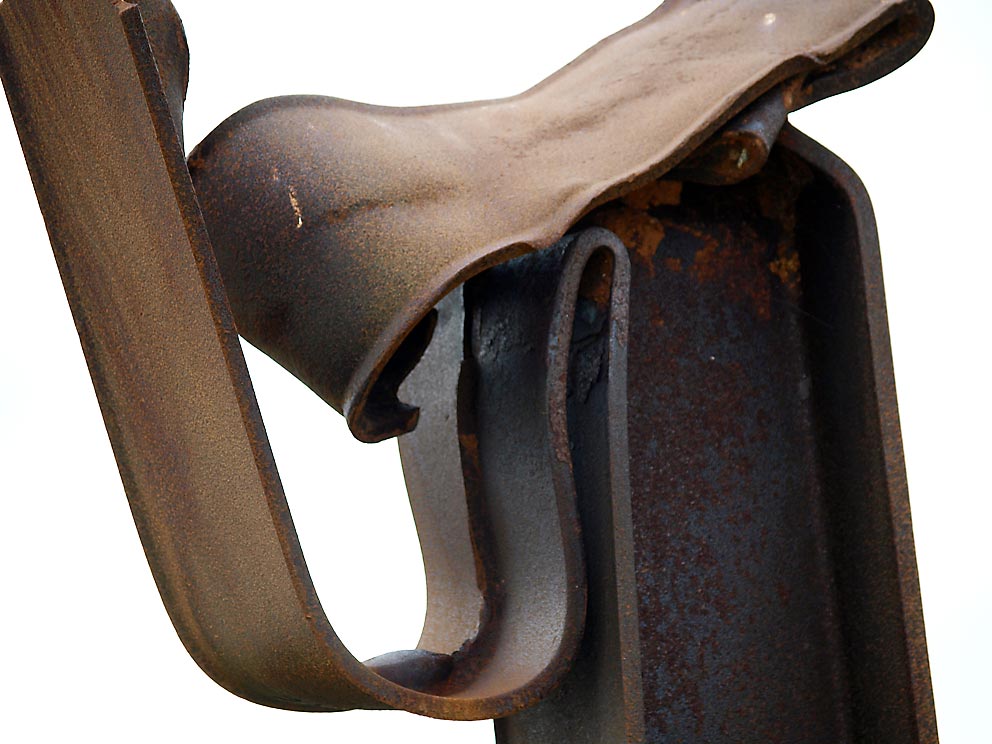Die Polizei rätselt über das Motiv des Mörders von Winnenden. Der Pfarrer verkündet von der Kanzel seine Kapitulation, indem er den Zuhörern suggeriert, wie hilf- und wehrlos doch alle seien. Kaum ein anderes Phänomen offenbart die gesellschaftsübergreifende Unfähigkeit, die wichtigste Frage des Dasein, der nach Leben und Tod, auch nur ansatzweise plausibel beantworten zu können, wie ein Amoklauf unter Kindern und Jugendlichen.
 Trauer um die Opfer von Winnenden. Bild: Kô-Sen
Trauer um die Opfer von Winnenden. Bild: Kô-Sen
Dabei käme kein Mensch auch nur auf die Idee, sich und andere zu meucheln, wenn er ahnte, dass er nach seinem finalen „Selbstmord“ weder tot ist noch den Konsequenzen seines Verbrechens entgeht, und welche Hölle er stattdessen betreten wird – und das für sehr lange Zeit. Mittelalterliches Kirchendogma und Neo-Materialismus, die Seele und Persönlichkeit als isoliertes Phänomen ohne ein realistisches1 Davor und Danach predigen, verhindern den Blick auf das tatsächliche Wesen des Menschen. Sie sind Teil einer Weltsicht, die Amokläufe auch zukünftig weder erklären noch verhindern kann.
Dabei sind die übermittelten Weisheitslehren hier ungewöhnlich offen. Ein Beispiel:
Die Selbstmörder, die in der törichten Hoffnung, dem Leben zu entgehen, (finden) sich weiter am Leben. Sie erwartet eine … Menge Leiden aus diesem Leben selbst. Ihre Strafe liegt in der Intensität desselben.
(DIE MAHATMA BRIEFE, Band 22)
Der Amokläufer landet im wahrsten Sinne
des Wortes in der Hölle – SEINE Hölle
Und nicht nur das. Aufgrund des äußerst intensiven Gefühlszustandes während der Tat, ätzt sich dem Täter das Geschehen in seine astrale Form ein. So wird der Amokläufer, der sich seines Körpers beraubt hat, nach nur kurzer Ohnmacht mit Entsetzen in einem dämmrigen Bewusstseinszustand erwachen. Er wird jetzt nicht nur das von ihm angerichtete Elend wahrnehmen, er wird bis zum Ablauf der ihm eigentlich zugewiesenen Lebenszeit das Grauen seines Verbrechens bis ins kleinste Detail immer und immer wieder durchleben.
Der Amokläufer landet damit im wahrsten Sinne des Wortes in der Hölle – SEINE Hölle. Um vor dem nicht enden wollenden Horror schließlich in die erst beste Möglichkeit zur Inkarnation zu flüchten, aber nur, um das verursachte Leid jetzt in einem neuen Körper angemessen zu büßen. Der irisch-amerikanische Mystiker und Theosoph, W. Q. Judge, hat Aspekte eines solchen Nachtodzustandes in dem Artikel „Suicide is not Death“ ausführlich beschrieben.
Suicide is not Death
By William Q. Judge
(This article first appeared in the New York World, September, 1894; reprinted in THE ECHOS OF THE ORIENT, San Diego, 1987.)
As a student of Theosophy and human nature I have been interested in the discussion of the subject of self-murder to which The World has given a place in its columns. The eloquent agnostic, Col. Ingersoll, planted his views in the ground with the roots of them in the grave, giving the poor felo de se nothing beyond the cold earth to cheer him in his act, save perhaps the cowardly chance of escape, from responsibility or pain. Those who, as Nym Crinkle says, occupy themselves with replying to Col. Ingersoll fall back on the mere assertion that it is a sin to kill the body in which the Lord saw fit to confine a man. Neither of these views is either satisfactory or scientific.
Wenn der Mensch lediglich ein Lehmklumpen ist – als KEIN seinem Wesen nach ungeborener unwandelbarer GEIST – was kann dann schlecht daran sein, ihn zu zerstören, wenn er dir gehört…
If suicide is to be approved it can only be on the ground that the man is only a body, which, being a clod, may well be put out of its sufferings. From this it would be an easy step to justify the killing of other bodies that may be in the way, or old, or insane, or decrepit, or vicious. For if the mass of clay called body is all that we are, if man is not a spirit unborn and changeless in essence, then what wrong can there be in destroying it when you own it, or are it, and how easy to find good and sufficient reason for disposing similarly of others? The priest condemns suicide, but one may be a Christian and yet hold the opinion that a quick release from earth brings possible heaven several years nearer. The Christian is not deterred from suicide by any good reasons advanced in his religion, but rather from cowardice. Death, whenever natural or forced has become a terror, is named „The King of Terrors.“ This is because, although a vague heaven is offered on the other side, life and death are so little understood that men had rather bear the ills they know than fly to others which are feared through ignorance of what those are.
Die Natur existiert ausschließlich zum Wohle der Seele… Und das ist nur durch einen Körper möglich, durch den die Seele mit der Natur in Verbindung treten kann3.
Suicide, like any other murder is a sin because it is a sudden disturbance of the harmony of the world. It is a sin because it defeats nature. Nature exists for the sake of the soul and for no other reason, it has the design, so to say, of giving the soul experience and self-consciousness. These can only be had by means of a body through which the soul comes in contact with nature, and to violently sever the connection before the natural time defeats the aim of nature, for the present compelling her, by her own slow processes, to restore the task left unfinished. And as those processes must go on through the soul that permitted the murder, more pain and suffering must follow.
Von den Folgen dieser Ungerechtigkeit (sich durch Suizid der Verantwortung zu entziehen) gibt es kein Entkommen, da der Tod des Körpers ihn nicht vom (verbleibenden) Rest trennt…
And the disturbance of the general harmony is a greater sin than most men think. They consider themselves alone, as separate, as not connected with others. But they are connected throughout the whole world with all other souls and minds. A subtle, actual, powerful band links them all together, and the instant one of all these millions disturbs the link the whole mass feels it by reaction through soul and mind, and can only return to a normal state through a painful adjustment. This adjustment is on the unseen, but all-important, planes of being in which the real man exists. Thus each murderer of self or of another imposes on entire humanity an unjustifiable burden. From this injustice he cannot escape, for his body’s death does not cut him off from the rest; it only places him, deprived of nature’s instruments, in the clutch of laws that are powerful and implacable, ceaseless in their operation and compulsory in their demands.
(Selbstmord) ist kein Tod, sondern lediglich das Verlassen eines wohl bekannten Heims in einem vertrauten Umfeld, um an einem neuen Ort zu landen, wo es nichts außer Schrecken und Verzweiflung gibt.
Suicide is a huge folly, because it places the committer of it in an infinitely worse position than he was in under the conditions from which he foolishly hoped to escape. It is not death. It is only a leaving of one well-known house in familiar surroundings to go into a new place where terror and despair alone have place. It is but a preliminary death done to the clay, which is put in the „cold embrace of the grave,“ leaving the man himself naked and alive, but out of mortal life and not in either heaven or hell.
(Der Mensch) ist ein dreifältiges Wesen – Körper, Seele, Geist…
The Theosophist sees that man is a complex being full of forces and faculties, which he uses in a body on earth. The body is only a part of his clothing; he himself lives also in other places. In sleep he lives in one, awakes in another, in thought in another. He is a threefold being of body, soul and spirit. And this trinity can be divided again into its necessary seven constituents. And just as he is threefold, so also is nature – material, psychical or astral, and spiritual. The material part of nature governs the body, the psychical affects the soul and the spirit lives in the spiritual, all being bound together. Were we but bodies, we might well commit them to material nature and the grave, but if we rush out of the material we must project ourselves into the psychical or astral. And as all nature proceeds with regularity under the government of law, we know that each combination has its own term of life before a natural and easy separation of the component parts can take place. A tree or a mineral or a man is a combination of elements or parts, and each must have its projected life term. If we violently and prematurely cut them off one from the other, certain consequences must ensue. Each constituent requires its own time for dissolution. And suicide being a violent destruction of the first element – body – the other two, of soul and spirit, are left without their natural instrument. The man then is but half dead, and is compelled by the law of his own being to wait until the natural term is reached.
(Der Selbstmörder) schießt sich in die Astralwelt, da er anderswo nicht mehr agieren kann…
The fate of the suicide is horrible in general. He has cut himself off from his body by using mechanical means that affect the body, but cannot touch the real man. He then is projected into the astral world, for he has to live somewhere. There the remorseless law, which acts really for his good, compels him to wait until he can properly die. Naturally he must wait, half dead, the months or years which, in the order of nature, would have rolled over him before body and soul and spirit could rightly separate. He becomes a shade; he lives in purgatory, so to say, called by the Theosophist the „place of desire and passion,“ or „Kama Loka.“ He exists in the astral realm entirely, eaten up by his own thoughts. Continually repeating in vivid thoughts the act by which he tried to stop his life’s pilgrimage, he at the same time sees the people and the place he left, but is not able to communicate with any one except, now and then, with some poor sensitive, who often is frightened by the visit. And often he fills the minds of living persons who may be sensitive to his thoughts with the picture of his own taking off, occasionally leading them to commit upon themselves the act of which he was guilty.
(Der Selbstmörder) kann denken, wahrnehmen…
To put it theosophically, the suicide has cut himself off on one side from the body and life which were necessary for his experience and evolution, and on the other from his spirit, his guide and „Father in heaven.“ He is composed now of astral body, which is of great tensile strength, informed and inflamed by his passions and desires. But a portion of his mind, called manas, is with him. He can think and perceive, but, ignorant of how to use the forces of that realm, he is swept hither and thither, unable to guide himself. His whole nature is in distress, and with it to a certain degree the whole of humanity, for through the spirit all are united. Thus he goes on, until the law of nature acting on his astral body, that begins to die, and then he falls into a sleep from which he awakens in time for a season of rest before beginning once more a life on earth. In his next reincarnation he may, if he sees fit, retrieve or compensate or suffer over again.
Gebt dem Menschen den Schlüssel zu seinem Wesen…
There is no escape from responsibility. The „sweet embrace of the wet clay“ is a delusion. It is better to bravely accept the inevitable, since it must be due to our errors in other older lives, and fill every duty, try to improve all opportunity. To teach suicide is a sin, for it leads some to commit it. To prohibit it without reason is useless, for our minds must have reasons for doing or not doing. And if we literally construe the words of the Bible, then there we find it says no murderer has a place but in hell. Such constructions satisfy but few in an age of critical investigation and hard analysis. But give men the key to their own natures, show them how law governs both here and beyond the grave, and their good sense will do the rest. An illogical nepenthe of the grave is as foolish as an illogical heaven for nothing4.
Bereits online im Trinosophie-Blog:
Amoklauf, Suizid … Anstiftung aus der Astralwelt 
- Die Auferstehung im Fleische, wie sie das Kirchenchristentum wörtlich lehrt, besitzt keinerlei Realitätsbezug, kann aus wissenschaftlicher Sicht bestenfalls im metaphorischen Sinne nachvollzogen werden. ↩
- Sattelsdorf, 1994 ↩
- Vergleichbar dem Serfen im Internet: Der Serfende ist die Seele. Um mit der Natur (=Internet) in Kontakt kommen zu können, braucht es einen Web-Browser (Körper). ↩
- Zwischenüberschriften und Hervorhebungen durch Redaktion ↩
Zuletzt aktualisiert: 15.03.2009 von Heinz Knotek






